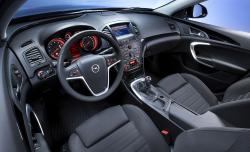Sep 22 2009
Hostacom compounded polypropylene (PP) resins produced by LyondellBasell Industries are being used to manufacture the interior components of Opel's new Insignia model, which received the 2009 European Car of the Year award.

"To be selected as one of the key suppliers of PP Compounds for the interior applications of the new Opel reflects not only our continuous innovation capabilities, but also the ongoing ability of PP compounded solutions to outperform other material concepts," said Wolfgang Jonischkeit, LyondellBasell's Customer Project Manager for Opel.
Several Hostacom compounded PP grades are being used to produce the instrument panel, door panel and pillar trim. "Opel required materials that address their needs for mechanical and safety properties, long service life, cost/performance balance and a superior, low-gloss surface finish," added Jonischkeit.
Key to this extraordinary performance is a new additive package used in the Hostacom PP compounds, which surpasses conventional PP compounds in terms of scratch resistance and surface properties. According to Opel's scratch and mar resistance tests, parts produced using the Hostacom grades with 15 percent filler demonstrated a much better surface appearance compared to other PP compounds on the market which contain nearly 20 percent filler. "The lower talc content also improves the density performance, enabling the production of lighter-weight parts while retaining all of the desired properties," said Jonischkeit. "The Hostacom grades also provide a good impact/stiffness balance and outstanding processability."
Meeting customer's requirements
Opel experts placed special emphasis on improving the aesthetics of the Insignia's visible parts. For the glove box and door panels, LyondellBasell provided a Hostacom TRC 160T grade, which features outstanding paint-bonding properties and allows the production of finished parts without the need for priming. "We helped Opel achieve a surface quality consistent with traditional coating solutions, while significantly reducing manufacturing chain complexity," said Rainer Köhler, Product Development Engineer at LyondellBasell.
Surface aesthetics also played a major role in the design of the upper pillar trim, as Opel required a material that displayed the same look and feel of the surface as traditional textile-laminated parts. Based on LyondellBasell's patented, customized Hostacom EKC 133N Multispot grade that includes carbon fibers, Opel was able to attain a surface quality comparable to conventional parts laminated with a textile layer.
Opel also use LyondellBasell's new soft-touch Catalloy resins, marketed under the trade name Softell, for a side cover (two-component application). Opel engineers required a flexible polymer that met the mechanical stress requirements for automotive seating. Softell grades also provide the necessary suppleness without sacrificing crash-relevant properties such as impact resistance.
Global specifications
As the Insignia has been launched globally, Opel required supply from LyondellBasell locations worldwide to ensure material consistency across all regions. "With 16 compounding production plants in 13 countries on five continents and all in close proximity to the OEM's manufacturing plants we provide the material consistency that global producers need," said Alain Gourjault, Automotive Marketing Manager at LyondellBasell.
The 2009 European Car of the Year has been acclaimed as the most outstanding new vehicle to enter the market in the last 12 months. The Insignia also received the coveted Red Dot Design Award for its innovative, trendsetting design.